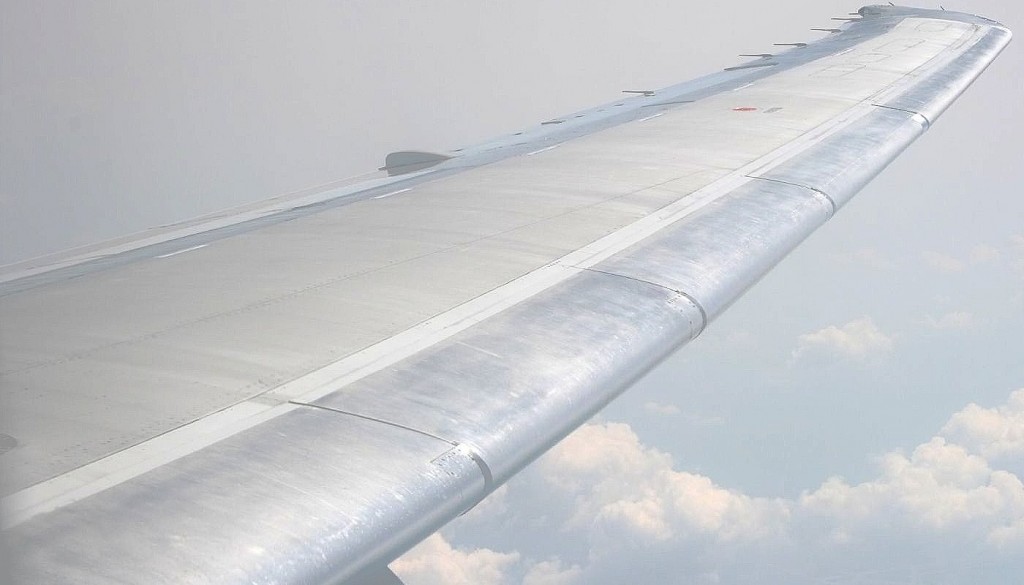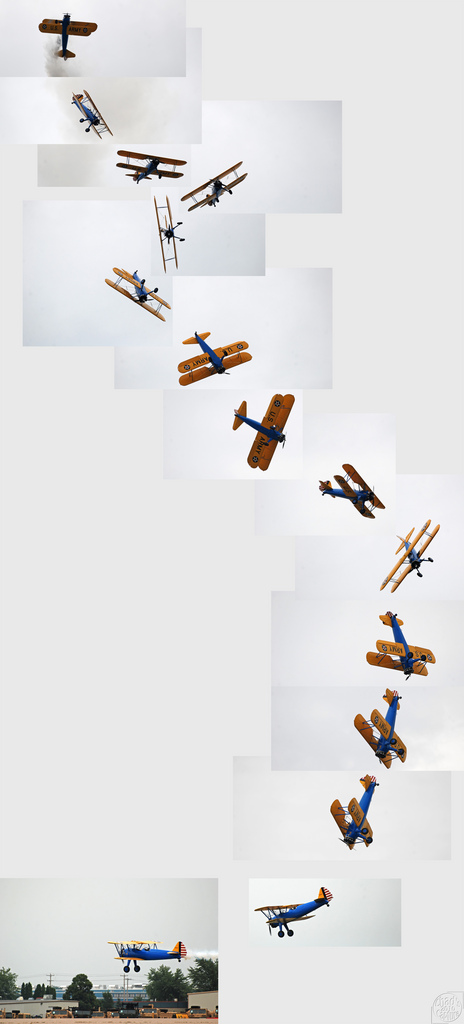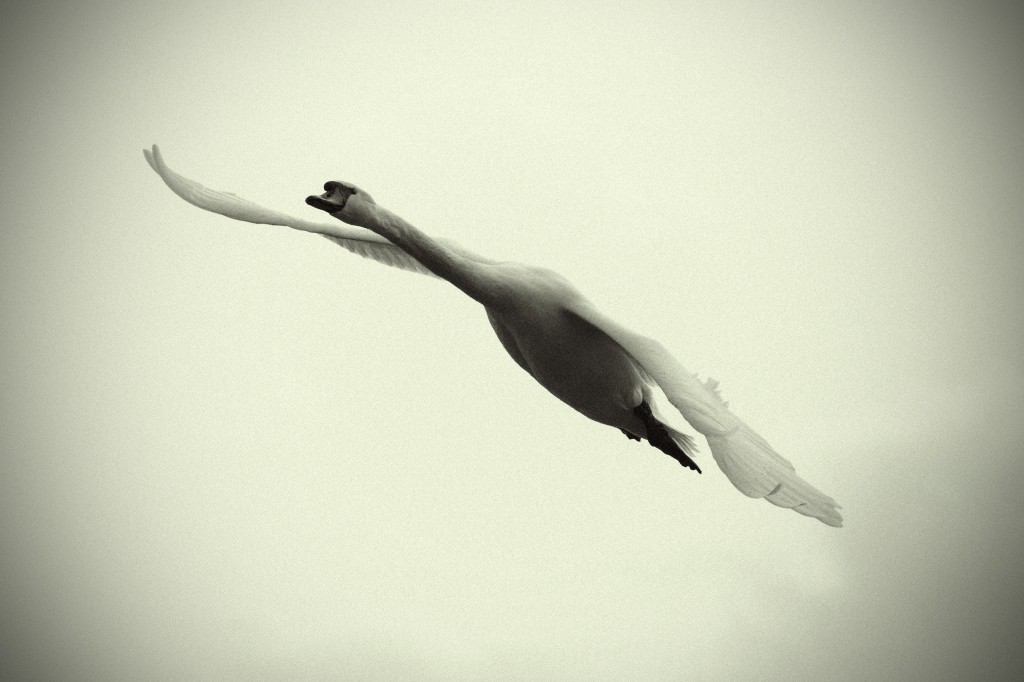 I asked my husband, who’s a physicist and a pilot, how airplanes stay up in the air. A question like that makes him happy. “It’s the wings,” he said, “They provide lift.” “What’s lift?” I said. “It’s Bernoulli,” he said. “The faster air moves, the lower its pressure. ” I’m used to these answers that are at a tangent to my questions and I usually get lost in them. “What’s faster air and lower pressure got to do with wings?” I said. He loves where this is going and talks louder. “Wings are airfoils,” he said. “They’re fatter at the leading edge and thin at the trailing edge. Air hits the airfoil and splits – think of it as streamlines. The streamlines that go up over the top of the wing speed up, and that lowers the pressure above the wing. The streamlines that go down under the wing go relatively slower, and that raises the pressure under the wing. So the wing is effectively pushed up. That’s lift.”
I asked my husband, who’s a physicist and a pilot, how airplanes stay up in the air. A question like that makes him happy. “It’s the wings,” he said, “They provide lift.” “What’s lift?” I said. “It’s Bernoulli,” he said. “The faster air moves, the lower its pressure. ” I’m used to these answers that are at a tangent to my questions and I usually get lost in them. “What’s faster air and lower pressure got to do with wings?” I said. He loves where this is going and talks louder. “Wings are airfoils,” he said. “They’re fatter at the leading edge and thin at the trailing edge. Air hits the airfoil and splits – think of it as streamlines. The streamlines that go up over the top of the wing speed up, and that lowers the pressure above the wing. The streamlines that go down under the wing go relatively slower, and that raises the pressure under the wing. So the wing is effectively pushed up. That’s lift.”
Ok, good, fine: faster air = lower pressure above, slower air = high pressure below, so then lift. “Is a wing moving through air always lifted?” I said. “No,” he said. “It depends on the angle of attack.” I’m also used to these infinitely receding explanations and I usually get lost in them too. “What’s the angle of attack?” I said. “Just the angle that the wing is at,” he said, and went on to remind me about driving in a car with my hand out the window and when my hand is tilted with respect to the oncoming wind, it gets lifted up. Ok, good fine: “so a wing angled for attack always has lift?” I said. “Not just lift,” he said. “Also drag. The act of creating lift also creates drag. It’s lift and drag.”
Also life and death, and order and entropy, I thought, so I asked, “could drag ever win?” “Oh yes,” he said, and digressed off into notable airplane crashes. I stopped listening.
 This is what happens. The streamlines going over the top not only speed up, they stop being streamlined, that is, they make little eddies, they get turbulent. That creates drag. “How do you stop that?” I said. “Lower the angle of attack,” he said, “and the streamlines over the top go even faster relative to the streamlines below, so it’s Bernoulli again. More lift,” and he digressed into the niceties of take-offs. “But lowering the angle of attack has got to stop lifting at some point?” I said. “Yes, it’s a balance – too low and not enough lift; too high and more turbulence and more drag,” he said, “and then you stall.” “Stall?” “The lift drops, the drag rises, the airplane starts sinking, then goes nose down.” “Oh no,” I said. “And the only way to recover it is to lower the nose still farther until you’re going so fast the lift picks up again and then you raise the angle of attack.” “Oh God,” I said. “But if you stall too close to the ground,” he said, and I interrupted him just as he was about to tell me about nosing in. “But spins are worse,” he said, and I stopped listening again.
This is what happens. The streamlines going over the top not only speed up, they stop being streamlined, that is, they make little eddies, they get turbulent. That creates drag. “How do you stop that?” I said. “Lower the angle of attack,” he said, “and the streamlines over the top go even faster relative to the streamlines below, so it’s Bernoulli again. More lift,” and he digressed into the niceties of take-offs. “But lowering the angle of attack has got to stop lifting at some point?” I said. “Yes, it’s a balance – too low and not enough lift; too high and more turbulence and more drag,” he said, “and then you stall.” “Stall?” “The lift drops, the drag rises, the airplane starts sinking, then goes nose down.” “Oh no,” I said. “And the only way to recover it is to lower the nose still farther until you’re going so fast the lift picks up again and then you raise the angle of attack.” “Oh God,” I said. “But if you stall too close to the ground,” he said, and I interrupted him just as he was about to tell me about nosing in. “But spins are worse,” he said, and I stopped listening again.
I’m already leaving out all the parts about friction and laminar flows and about how Bernoulli is just one description but another one is Newton and conservation laws and circulation around the wing, and I don’t know what all. “And birds?” I said. “No, no,” he said, getting all torqued up, “birds are MUCH more complicated, birds can change the shape of their wings, bird have individual muscles for each feather and move their feathers individually,” and he put his arms out and zoomed around the room, waggling his fingers and shouting about flaps and elevators. Sometimes my nerves aren’t quite strong enough for physics.
 My husband and a gentler physicist, Princeton’s Will Happer, went to school together. Happer liked his first meetings with physicist/pilots: “They knew from the seat of their pants about lift and drag. I liked to go stand by the coffee and just listen to them talk. I’d never known how you calculate lift and drag, and there’s a beautiful law about the lift of a wing that says the lift is proportional to the circulation of the fluid around the wing times the velocity of the wing. And you know, it’s like a sonnet almost, it’s so pretty. It’s the most fundamental conservation laws of physics, when a fluid accelerates and goes faster, its pressure goes down, the famous Bernoulli effect.”
My husband and a gentler physicist, Princeton’s Will Happer, went to school together. Happer liked his first meetings with physicist/pilots: “They knew from the seat of their pants about lift and drag. I liked to go stand by the coffee and just listen to them talk. I’d never known how you calculate lift and drag, and there’s a beautiful law about the lift of a wing that says the lift is proportional to the circulation of the fluid around the wing times the velocity of the wing. And you know, it’s like a sonnet almost, it’s so pretty. It’s the most fundamental conservation laws of physics, when a fluid accelerates and goes faster, its pressure goes down, the famous Bernoulli effect.”
Happer went on to explain how those fundamental laws operate even when the wing stalls. “I learned that when a wing stalls, it’s not like when your car stalls—it means that the wing stops lifting and the plane falls to the ground.” But Happer isn’t a pilot so to him, stalling was just part of lift; it was just physics and he loves physics. “I learned things that were simple and beautiful and calculable,” he said, “these simple ideas that made something that was so complicated and seemingly intractable and inscrutable, suddenly crystal clear and self-evident.”
You can’t make lift without making drag. Stalling follows laws. And so the danger of a crash — that seemed unpredictable, intractable, inscrutable — becomes crystal clear and self-evident. For some reason that’s a comfort.
_________
If you noticed the similarities of drag, velocities, and differing, calculable fates between this post and Richard’s yesterday, you wouldn’t be entirely wrong.
Photo credits: wing – MNicoleM; recovery from spin not too close to the ground – Chad Horwedel; swan – kennysarmy
I, at this moment, can hear this discussion in my mind and even picture the body language and gesture-rich demonstrations. Beautiful description, and this is also the first time I ever understood the Bernouli effect. Very nice.
Yes, Spence, yes you can. In fact, you probably have heard it in person too, only between Oliver and Cal. I’m glad you liked it.
What a marvelous, beautiful explanation of flight.
I am sharing this with my dad, a physics instructor/pilot. Maybe he’ll use it in his course on the physics of aviation.
http://home.comcast.net/~friesend/ This is far superior to any textbook explanation of the Bernoulli effect I’ve ever seen.
I love that compliment. Your father will doubtless notice small misdirections and inaccuracies, just as my husband did. “It’s right ENGOUGH,” he said. “It’s not WRONG.” He really wanted me to talk about the way the streamlines separate from the wing but I just couldn’t inflict that on the reader. He also really wanted me to let him write it himself but I convinced him to stick to airplanes and I’d stick to writing.
Oh my gosh, I am never going up in one of those things again (unless your husband’s on board of course, he’ll know exactly what to do).
I’m sure I remember reading somewhere that the act of landing a plane is actually a controlled stall – does that sound right? It feels right from the theory.
And yes, I did notice the parallels with Richard’s post. And the poetry.
Tim, I asked my husband: “Yes, a landing is a controlled stall. In the ideal landing, the airplane goes into full stall just as you touch down. That minimizes your forward speed and that makes landing safer.”
I merely take dictation. And shudder.
Ann, You have captured a type of conversation I have so many times with my non-science friends. Your husband and I seem to think alike! I enjoyed your description of being on the receiving end of a scientist trying to get someone to understand…
I come close to buying the two-cultures business, Nick. The differences are not just in language and training but in ways of thinking and reacting. But do I give up? Never. I never give up.
This is a very common explanation of how lift is created, unfortunately it’s not strictly correct. It’s a bit surprising that a physicist would convey this mis-information, but a nuclear scientist would not be expected to understand the nuances of fluid dynamics, I suppose.
Anyway, lift is created by downwash, which is deflection of the air downward. The air has mass, and as the wing moves through the air, the air is deflected downward by the shape of the wing. It’s hard to think of the air as supporting an airplane in this manner, because air seems so light and…airy, but it’s a lot of air. To help understand this mechanism of downwash, imagine a bunch of gnomes strapped to the back of the wing and the airplane is flying along rows of horizontal racks of bowling balls. The gnomes continuously grab bowling balls off the rack and hurl them downward, and the airplane is supported by the reaction of the downward accelerating bowling balls. The upward force is Newton’s action-reaction mechanism. Blow up a balloon and let it go flying around the room. The balloon is propelled by the air being accelerated out the balloon nozzle.
Next, when a wing stalls, it does not stop lifting, not even close. When a wing stalls the wing is still producing most of the lift that it was generating prior to stall. The airplane accelerates downward because there is a net imbalance of forces, but the wing is still producing a large amount of lift.
Non aerodynamacists should not write articles explaining how airplane wings produce lift, even if they are married to physicists (who also don’t understand the principles).
Nice photos.
Daniel, thank you for writing; I didn’t think my explanation was strictly correct; my husband told me the Bernoulli and Newtonian explanations were complementary and I needed to understand both; but I wrote only about Bernoulli anyway and said so and gave the reader a link to the Newtonian; you give a nice explanation of the Newtonian; I didn’t say a stalling wing stops lifting, I said the lift drops and the drag rises; I’m glad you like the photos. Now I’m going to sit quietly and think about gnomes, bowling balls, and balloons.
I love the description of that conversation. I’m also a physics/pilot type and have often tried to bridge that gap in discussions with my wife and others. It’s true that Bernoulli is often given more credit than deserved and that “downwash” and action/reaction is closer to the truth. There’s an excellent book that emphasizes intuitive and physical understanding without equations, “Understanding Flight” (2nd Ed.) by David Anderson and Scott Eberhardt. That book says that if you had to sum up lift in one sentence, it would be “the wing produces lift by diverting air down.” Another great (and free) resource is the web site “See How It Flies” by John Denker. Denker is a physicist and flight instructor and this is more for pilots and aspiring pilots, nicely integrating the how-to and the why of all aspects of flight.
Bruce and Daniel would both be comforted to hear the conversation last night after dinner:
Stepson (also a pilot): Yeah, that’s ok but really the wing is pushing the air down.
Me: But Bernoulli is right too.
Husband (to son): You’re talking about Newton. He’s right too.
Stepson: Yes but Bernoulli gets all the credit.
Thank you, Bruce, for the references and for the civility of your argument.
One more thing about “pushing down air.” Airplanes are heavy, and air seems pretty light, doesn’t it? In “Understanding Flight” they give an approximate example for a common light plane, the Cessna 172, which weighs about 2300 lbs. (sorry metric people! about a metric tonne). Cruising level at about 140 mph, it turns out that this little airplane is pushing down about 5 times its weight of air PER SECOND. That’s about 5 TONS (or tonnes) of air per second that its wings are diverting to create the reaction force (lift) that holds it up steadily in straight and level flight. Air is mighty powerful stuff!